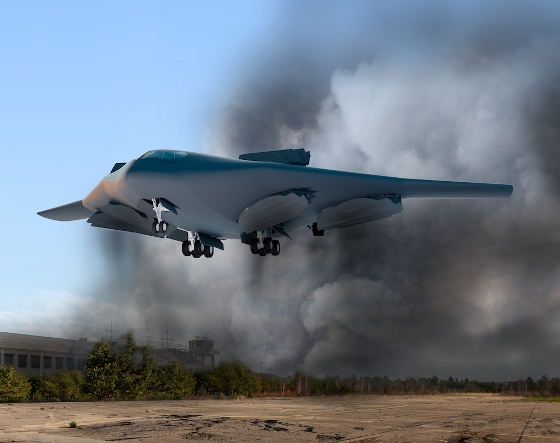 |
| October 22, 2024 | Volume 20 Issue 40 |
Designfax weekly eMagazine
Archives
Partners
Manufacturing Center
Product Spotlight
Modern Applications News
Metalworking Ideas For
Today's Job Shops
Tooling and Production
Strategies for large
metalworking plants
Fan-in-wing tech powers new concept for military vertical lift plane

[Credit: Image courtesy of Aurora Flight Sciences]
A new X-plane being developed by Aurora Flight Sciences, a Boeing company, uses fan-in-wing (FIW) technology to provide high-speed, runway-independent mobility for military contested environments. Newly released renderings of the vertical lift concept depict a scalable technology for airborne logistics and personnel recovery missions in locations without a prepared runway.
Vertical takeoff and landing (VTOL) technologies are a hot area of study for the Defense Advanced Research Projects Agency (DARPA) and the U.S. military at large. The high-flying design work from Aurora is part of DARPA's Speed and Runway Independent Technologies (SPRINT) program, which aims to "design, build, and fly an X-plane to demonstrate the key technologies and integrated concepts that enable a transformational combination of aircraft speed and runway independence."

Artist's rendering of Aurora Flight Sciences' DARPA (small) and a larger demonstrator aircraft that use fan-in-wing technology that combines an embedded lift fan with a blended wing body design. [Credit: Image courtesy of Aurora Flight Sciences]
According to DARPA, "Even as VTOL aircraft technology continues to advance, one key goal still remains elusive: improving top speed beyond 150 kt-170 kt. Faster VTOL aircraft could shorten mission times and increase the potential for successful operations, while reducing vulnerability to enemy attack. Unfortunately, new VTOL designs so far have been unable to increase top speed without unacceptable compromises in range, efficiency, useful payload, or simplicity of design."
DARPA's VTOL X-plane program aims to overcome these challenges through innovative cross-pollination between the fixed-wing and rotary-wing worlds. DARPA's VTOL X-Plane program ultimately seeks to create a single hybrid aircraft that would simultaneously to push the envelope in four areas:
- Achieve a top sustained flight speed of 300 kt to 400 kt.
- Raise aircraft hover efficiency from 60 percent to at least 75 percent.
- Present a more favorable cruise lift-to-drag ratio of at least 10, up from 5 to 6.
- Carry a useful load of at least 40 percent of the vehicle's projected gross weight.
Aurora and Boeing are collaborating on the development of key technologies that combine to deliver a revolutionary solution to mobility challenges in contested environments and across distributed military bases. Fan-in-wing technology combines an embedded lift fan with a blended wing body design to enable vertical lift agility without sacrificing the payload capacity and aerodynamic efficiency associated with today's fixed-wing aircraft.

Artist's rendering of Aurora Flight Sciences' demonstrator for the DARPA SPRINT program. [Credit: Image courtesy of Aurora Flight Sciences]
The Aurora team is currently designing an uncrewed DARPA demonstrator with a 45-ft wingspan and 1,000-lb payload capacity for the SPRINT program. The propulsion system includes off-the-shelf turbofan and turboshaft engines that would power the vehicle to a maximum of 450 knots true airspeed (KTAS).

Aurora's "vision system" concept showing SPRINT technologies scaled for use in larger aircraft. [Credit: Image courtesy of Aurora Flight Sciences]
Once perfected, the SPRINT X-plane technology could be scaled to medium- and heavy-lift aircraft, creating a future family of systems. For example, Aurora envisions a manned, 130-ft wingspan aircraft with four lift fans and 40-ft payload bay. The FIW aircraft could meet or exceed the payloads, ranges, and speeds typical of fixed-wing military transport aircraft while delivering the tactical advantage of true vertical takeoff and landing.
"The SPRINT program offers the opportunity to deliver a game-changing capability to the warfighter," said Mike Caimona, president and CEO of Aurora Flight Sciences. "High-speed, stealth, runway-independent transport could help keep warfighters safe and effective in contested environments, so no domain is out of reach for our U.S. military."

Early SPIRNT model aircraft (DARPA uncrewed demonstrator). [Credit: Image courtesy of Aurora Flight Sciences]
Earlier this year, the Aurora team completed the first of three major test events scheduled for the current phase of the SPRINT program to prove out the feasibility of the FIW technology.
The ground-effect test, conducted using a 4.6-ft wingspan model with three lift fans, showed that suck-down effects created by the lift fans in hover were negligible, and that the landing gear is set to the appropriate height to minimize adverse pitching moments from forming during ground operations.
Wind tunnel tests planned for late 2024 and early 2025 include a stability and control test using a 9-ft full wingspan aircraft model and a 5.25-ft semi-span embedded lift fan test to model aerodynamic effects.
The current phase of the program continues through May 2025, with a preliminary design review scheduled for April 2025. Flight testing for the program is planned for 2027.
Sources: Aurora Flight Sciences, DARPA
Published October 2024
Rate this article
View our terms of use and privacy policy
